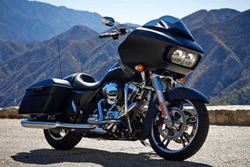Lessons from Harley-Davidson on Seasonal Marketing
Like many brands, Harley-Davidson maximizes its marketing efforts during peak times— the riding season, holidays and key motorcycle rallies—to generate the most sales it can.
“If there is a more seasonal business than motorcycles I’d like to hear about it,” Aaron Ormond, manager, customer lifecycle management, for the Harley-Davidson Motor Co., said yesterday at the Modern Marketing Experience in Las Vegas.

Two months ago, in the run up to marketing the riding season, one email newsletter was versioned for both males and females by swapping out the gender of the person riding a Harley on the lead image. The version for young adults was a different interpretation of the same email blazoned with the marketing message, “This sense of liberation and freedom.”
When planning for its peak season marketing with partner Oracle the strategy addresses three buckets, then the dots are connected for a seamless execution, he said.
1. Historical Benchmarks Harley looks at what was done in the past. What worked, what didn’t? What have its competitors done? What are the opportunities? What can be improved upon to drive results? As an example, when Harley looked back at holiday 2013, it learned that focusing on specific merchandise categories could improve results. So, in 2014 it focused marketing in multiple areas like gifts under $100 and gift cards.
“That drove a lot of business,” Ormond said.
2. Identifying Consumer Behaviors Ask questions to help identify those behaviors. When do consumers start thinking about a holiday event or product? At what point did consumers historically take action, make a purchased, register for an event or respond to marketing materials? What mindset will the consumer be in during the event? What overarching behavioral trends will have an impact on consumers during the event? Mobile is great example to watch closely since consumer behavior shifts every year, Chris Wilson, strategic consultant, Oracle Marketing Cloud, said.
Wilson suggests searching Google trends to see when spikes happen during key words and phrases. Tap consumer research studies from Experian, Forrester, eMarketer, Marketing Sherpa and Marketingcharts.com. Use competitive analysis (Return Path’s Inbox Insight or eDataSource’s EDS Analyst). And, of course brand research—internal findings and qualitative analysis, as well as visible trends or consumer behaviors observed.
3. Brand Events Clearly define objectives and event details (dates, location, product pricing, etc.) and the customer segments that the event applies to.
“This past holiday we matched up those three historical benchmarks with what we did the prior year and looked at, ‘what do we need to do from a biz standpoint?’ We put together a great plan and saw a 15% increase in year-over-year revenue from email during the holiday,” Ormond said.
“Automation is key,” Wilson said. “Doing more with less. During peak seasons the key is to identify areas to drive results through program automation, pinpoint interests in real-time to drive personalized content and target non-responders to drive incremental results.”
Harley used behavior targeting to drive content and results. Real-time interests were identified through click tracking. During the holidays, creative was versioned based on shopping behavior. For example, it tested emails with both male and female products and then followed up with new emails based on the responses. The tests drew 15% to 32% lifts in click-through rates and was rolled out across most programs, Ormond said.
Harley was fearless in testing during the very important seasonal timeframe, but other marketers see it as risky for these five reasons, he said.
- Communications are timely and the brand can’t risk delays
- Marketers are already dealing with more approvals than usual
- Not enough time to apply test learnings during peak season
- Marketers don’t want to sacrifice results for the sake of testing
- Resource constraints
But if marketers are willing, the results can be impressive. “We were able to imbed testing into our holiday this past year and saw great results,” Ormond said.
Harley-Davidson is more global now and growing more diverse in its customer segments. It is reaching out to a new group of customers—young females who have shown increasing interest in owning and driving motorcycles. This year in the U.S., Harley will teach more than 37,000 students how to ride a motorcycle and many will be female. It also has its most passionate riders—the owner’s group—to take care of.
In addition to Haley’s line of motorcycles, it also drives big business in motor clothing and personal accessories for its bikes. Its ecommerce site has been open a mere two years.
Mobile Fast Facts
* 70% of people in the U.S. would like to receive offers on mobile
* Text messages are read on average within 5 seconds
* 64% of consumers subscribed to mobile marketing indicate they have made a purchase as a result of receiving a highly relevant mobile message
The types of mobile offers most likely to trigger consumer action according to Oracle are:
* Price based 66%
* Time sensitive 52%
* Location based 50%
* SMS coupons are 10 times more likely to be redeemed
Despite the stats, Harley was “a little hesitate to jump into SMS because we want to respect that inbox a little bit,” but decided to take the leap with one of its most popular bike rallies, Ormond said.
It all started with the Road Glide, Harley’s popular touring motorcycle loaded with attitude and a very loyal customer base. Three years ago it stopped building the bikes and heard about it that decision from some of those customers. In the background, Harley knew it would remarket the Glides in 2014, but had not let customers know.

Harley decided to announce the return of the shark-nosed Road Glide motorcycle in August 2014 at the Sturgis Road Rally, a massive bike rally that draws some 400,000 bikers. Emails were delivered to 80,000 Road Glide enthusiasts asking for their cell numbers to learn about a “big announcement.”
SMS messaging was then used to communicate with Sturgis attendees to let them know when and where to meet for the big announcement. The night before the big reveal, a text went out saying the big announcement would be made the next day and for all to meet at Tin Lizzy where the 2015 Road Glide was unveiled just for them backed by the marketing plan “It’s Back,” using the hash tag #RoadGlide.
A huge parade of old and new Glides rode into town. A video captured the event that was then posted online.
“Some 21% of Glide owners opted-in to receive the messages,” Ormond said. “It was great for us to wade into SMS at a really important time.”
In another example using multiple channels, Harley identified 400,000 consumers in its database that were the right target for its new touring bike—huge sellers—as part of its Project Rushmore. It merged email, social and display ads so that when consumers received an email that talked about the new comfort features on the bike, they also saw a display add and social messages. This campaign drew 9% higher conversion rates for customers that were part of that multi-touch, orchestrated program.
Top 5 Tips to Test Flawlessly During Peak Seasons
- Start planning early—ideally five to nine months out
- Make testing a priority for your team
- Dedicate time and resources for testing
- Keep it simple—only test one effort at a time, especially during peak time.
- Focus on major variables that will generate the most impact.
“During the motorcycle season, young adults are a huge focus for us.

We are making a huge effort to reach out to those customers. One thing we know they buy early in spring—March and April—so we’re coming out of the gate really strong.”
Harley’s new campaign, “Roll Your Own,” targets that young segment with a heavy load of print, TV spots, online ads and social to smash the stereotype of who rides Harley bikes.
































